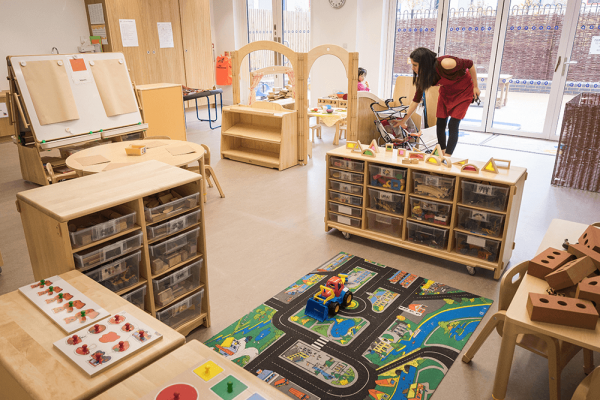As congregations age and shrink across the U.S., churches find their sizable buildings often become underutilized.
“Churches have extra space that’s totally unused,” said Rev. Jill Daniel, a minister with the Texas Conference of the United Methodist Church. Rural and city churches are both prone to the shifts that create underuse, but it carries a different weight in rural towns where there aren’t many libraries, event centers, hotel ballrooms, or even office buildings; churches and schools become convening spots for more than just Sunday worship.
But as they decline in membership, some churches struggle to keep up the programming that made them a community hub. The maintenance on an underutilized building can be a burden, according to Tim Cool, founder of Smart Church Solutions, a company specializing in church use. For some it can lead not only to debt troubles and deferred maintenance, it can also make the church feel empty or like it’s lost vitality.
Daniel found the solution to rural churches’ excess space problem in a different crisis: early childhood education. Daniel said that church-based education centers can be a way to help churches revitalize their buildings and congregational life while serving the community.
In 2019, the Bipartisan Policy Center surveyed community-based child care options across 25 states and found that of the nearly 9 million children who could potentially need child care, there were only accessible options for 59 percent of them. But the pandemic strained an already fragile early childhood educational ecosystem to its breaking point, and recovery has been slow, leaving thousands of Americans without access to the affordable, high-quality care they want for their children.
Daniel, who spent 30 years working in child care before becoming a priest, knows the difference a quality early childhood center can make for a community, and so do the churches she works with. Many churches have looked into starting some kind of early childhood center, but shelved the plans when they saw the initial work it would require.
“Child care licensing is scary looking if you’ve never done it before,” Daniel said. Churches, unlike school districts and franchise centers, don’t have a central resource to keep track of regulations, best practices, and governance.
In 2019, Daniel’s Methodist Texas conference started the “We Love All God’s Children” initiative in October 2019, and since then has opened 14 early childhood centers or preschools through Methodist churches in Texas.“We had way more churches interested than I ever thought,” Daniel said.
The conference provides supplies from crayons to playground equipment, as well as staff training, parent handbooks, and curriculum. Running a successful early education program is rarely something a congregation can manage themselves, so professional staff are brought in and the church has little to do in the day to day operations.
Beyond operations, Daniel helps facility administrators connect to funds like the Moody Methodist Church Permanent Endowment to update the buildings in preparation for a school full of kids. “If you’ve never had 60 kids in there flushing (toilets), it’s a big deal,” she said.
We Love All God’s Children has also worked with the Texas Workforce Commission to get subsidies for centers that qualify for certain designations. The highest rating from the state allows workers to get health insurance at a minimal cost — a rare attempt to alleviate some of the compensation deficiencies that have driven workers from the field.
The tangled threads of child care
Roughly 15 percent of working families use faith-based child care centers, so allowing church-based programs to participate in state-funded child care expansion or improvement programs is essential, said Marica Cox Mitchell, vice president of early childhood at the Bainum Family Foundation, a nonprofit that supports early childhood programs and the Seventh-Day Adventist schools and communities. Early childhood education programs in churches are a critical part of the child care ecosystem, she said, and any plan to close the gaps in access should take that into account. At the same time, parents need to know what they’ll get at a church-based school, the way that they know what to expect from a dentist, architect, and others who are obligated to adhere to professional standards.
'“When you put a shingle out that says ‘architecture firm’ or ‘pharmacy,’ it means something,” she said. The same should be true for a sign that says ‘early childhood education center.’”
Currently, when a parent is looking for care for their child under 5, it’s hard to know the difference between a preschool, mother’s day out, daycare center, and an early childhood education center. Some are affiliated with Head Start — a program of the U.S. Health Department — others with local school districts, and others are small businesses that rely solely on tuition. Some meet national quality standards for early childhood education professionals, others meet state or federal quality standards to access government funding but most can operate and meet neither. And for parents who prefer to have a trusted family member or comparable caregiver serve as their primary child care provider, support is slim to none. Child care in the U.S. is a patchwork, and that patchwork makes both funding and quality uneven.
Cox Mitchell said when the Biden administration’s Build Back Better plan proposed more funding for prekindergarten programs and child care, the threads in the patchwork began to unravel as various groups weighed in. Child care was gutted from the bill by the House of Representatives, and Republicans cited the lack of inclusion for faith-based and home-based programs. Cox Mitchell said the child care sector needs a more comprehensive and coherent vision — a way to streamline both funding and oversight — to be ready for the next opportunity to tackle the U.S.’s child care crisis.
To that end, the Bainum Family Foundation released WeVision Early Ed, a report based on a year-long collaboration between practitioners and families, to try to map out what families and early childhood education professionals want in their ideal child care system and what it will take to make their ideal real. It includes guidance for how the government could standardize and support early childhood offerings from ages 0-5, whether through centers, schools, churches, or home-based businesses. The report even includes recommendations for how to support families who choose family members or trusted adults to care for their children — a group often left out of such efforts.
Cox Mitchell said some church-based schools may face challenges if their approach to faith-based education conflicts with the profession-led standards that should guide government regulations and funding eligibility. They wouldn’t be able to, for example, deny acceptance to non-Christian families. But it’s worth having the conversation, Cox Mitchell said, to ensure that all parents have access to their preferred options and to meaningful information about what those options mean. She suggested examining religiously affiliated nonprofit organizations in the health care and social services industries, as those may provide some insights to help navigate this complexity. Government regulations, which are closely aligned with profession-led quality standards, are non-negotiables for religiously affiliated nonprofit organizations hoping to receive government funds for their core services.
Daniel agrees the streamlining would be beneficial. “Churches call them schools, but you don’t always know,” she said. A uniform standard of hours and certifications would be helpful, especially if that allowed more federal funding to make the start-up less of a hurdle.
Currently the Texas United Methodist programs are designed to become self-sustaining, and they typically do, Daniel said. Most even create a stabilizing income for the churches, though that’s not the goal. The main benefit to churches, Daniel said, is rejuvenation, bringing life back into long-shuttered corridors. The churches have learned that just because the halls are full during the week doesn’t mean the pews will be full on Sunday, but it has encouraged them to engage the young families, let them know about other services the church can provide, and in a few cases, she said, families have found a church home through enrolling their kids in the school.
Got something to say about what you're reading? We value your feedback!







